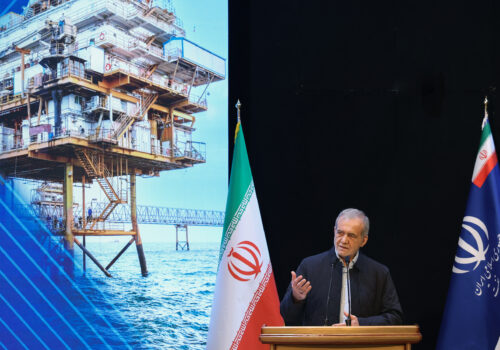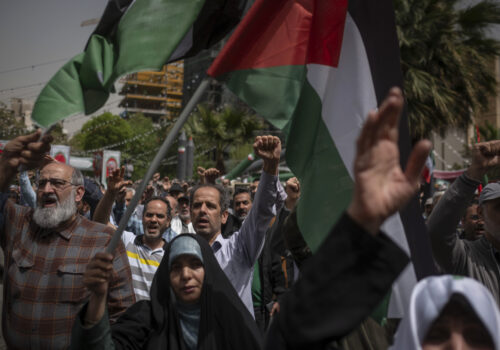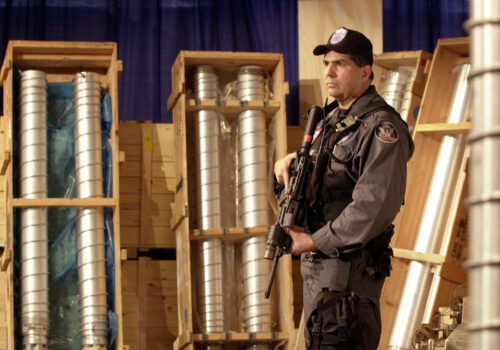Feeding the ‘water mafia’: Sanctions relief and Iran’s water crisis
As temperatures soar and Iran’s water and power crises deepen, many officials are once again pinning their hopes on sanctions relief and a potential deal with the United States. They argue that freeing up frozen assets could ease shortages and stabilize the country. But decades of bitter experience suggest otherwise: without deep structural reform, more money will not save Iran—it will only hasten collapse.
Earlier this week, US President Donald Trump made headlines by stating what many Iranians have known for years: a corrupt “water mafia” has looted the nation’s resources while its leaders have “managed to turn fertile farmland into dry deserts.” He underscored the regime’s role in fueling the crisis, declaring that “their corrupt water mafia—it’s called the water mafia—causes droughts and empty riverbeds. They get rich, but don’t let the people have any of it.”
For millions of Iranians displaced by environmental degradation and water scarcity, it was the first time a sitting US president openly echoed what whistleblowers and environmental advocates have been shouting for decades.
The term “water mafia” has been used by Iranian journalists, scientists, and activists for more than a decade to describe a powerful and politically connected network responsible for pushing ecologically catastrophic megaprojects. These actors thrive on opacity, benefiting from unchecked dam-building, wasteful water transfers, and the relentless overextraction of groundwater, often under the guise of development and national security. Trump’s remarks may have been blunt, but they captured the essence of the crisis: Iran is not just running out of water, it is being robbed of it.
The aftermath of the 2015 Joint Comprehensive Plan of Action (JCPOA) nuclear deal offered a clear warning. Billions of dollars flowed back into Iran, yet no serious reforms followed. Instead, environmental destruction accelerated. Expensive dam-building and ill-conceived water transfer projects continued unchecked, groundwater depletion worsened, and land subsidence spread across critical plains. Agricultural practices remained wasteful, and environmental priorities were ignored.
In the Islamic Republic, the reflexive belief that crises can be drowned in money has repeatedly backfired. Over the past four decades—particularly since the Iran-Iraq War—financial windfalls without transparency, accountability, or public participation have fueled corruption, exacerbated environmental damage, and triggered deeper social unrest. Funds intended for resilience and renewal have instead bankrolled inefficient megaprojects, enriching politically connected contractors while pushing the country’s ecosystems closer to collapse.
Parliament and oversight bodies have long been reduced to hollow institutions, offering little more than a façade of accountability. Public dissent—especially from provinces ravaged by water scarcity—has been met with suppression, not solutions. Now, with the prospect of ongoing US negotiations delivering some sanctions relief, the economic arm of the Islamic Revolutionary Guard Corps, the Khatam al-Anbiya Construction Headquarters, stands ready to tighten its grip. Under the banners of “development” and “poverty alleviation,” it will likely expand its empire of megaprojects—ventures that, without environmental safeguards or transparency, have consistently deepened corruption, entrenched inefficiency, and accelerated environmental collapse.
Widespread corruption and lack of oversight
Water governance in Iran is tightly controlled by the Supreme Water Council—a body that exists more as a rubber stamp for elite interests than a forum for sustainable planning. Dominated by the Ministry of Energy, with the president or vice president merely present in name, the council has consistently prioritized unsustainable development over ecological integrity. In practice, it has functioned as a front for the water mafia—an entrenched network of bureaucrats, contractors, and cronies whose goal is profit, not preservation.
The Ministry of Agriculture, as the largest water consumer, is a major influencer within this council. Civil society and non-governmental organizations are almost entirely excluded from decision-making, and local stakeholders lack the ability to prevent resource destruction. The Department of Environment, while occasionally voicing concerns, has been reduced to a ceremonial role.
SIGN UP FOR THIS WEEK IN THE MIDEAST NEWSLETTER
Most large-scale water projects in recent decades have either bypassed environmental permits or obtained them under pressure, often through compromised processes involving firms with direct ties to the water mafia. In cases where local courts attempted to intervene, rulings were ignored or overruled by higher judicial officials loyal to political interests. Environmental defenders and whistleblowers who challenge these projects face intense security pressures, harassment, and, in many cases, exile.
Powerful consulting firms, many of which have long benefited from insider connections, have greenlit projects that have devastated entire ecosystems, displacing upstream communities, triggering deforestation, damaging cultural heritage sites, salinizing rivers, depleting aquifers, and contributing to widespread land subsidence in urban and agricultural zones alike. From Tehran to Isfahan, cities are literally sinking under the weight of institutional negligence. These aren’t development projects—they’re environmental crimes disguised as infrastructure. And if sanctions are lifted and new capital flows into the system without strict oversight, the water mafia will seize the opportunity to expand its empire, accelerating Iran’s ecological collapse.
IRGC involvement
The Islamic Revolutionary Guard Corps (IRGC), through its Khatam al-Anbiya Construction Headquarters, has become Iran’s largest and most politically untouchable contractor, positioned squarely at the center of what many now call the “water mafia.” This deeply entrenched network includes senior officials within the Ministry of Energy, politically favored consultants, and powerful construction and engineering firms. Shielded by military influence and judicial complicity, they operate with near-total impunity. Whenever a major dam or inter-basin water transfer project is launched, Khatam is either directly involved or quietly profiting through layers of subcontractors. Although sanctions have constrained some of its operations in recent years, the IRGC has routinely sidestepped these limits by deploying a spiderweb of front companies to keep cash and construction flowing behind the scenes.
Any future sanctions relief would give Khatam and the broader IRGC-industrial complex even greater control over state development budgets, further emboldening the water mafia. Since its post-1989 transformation, engineered by former President Akbar Hashemi Rafsanjani and sanctioned by Supreme Leader Ali Khamenei, Khatam has overseen disastrous megaprojects.
Those include the Karkheh and Gotvand dams, which have inflicted irreversible ecological damage across Khuzestan. Its inter-basin water transfer schemes, including the Garm-Siri project, not only jeopardize domestic water security but risk igniting future disputes with Iraq over shared river systems. Far from alleviating Iran’s water crisis, the JCPOA-era influx of capital largely served to reinforce the very machinery driving the collapse.
Lack of environmental impact assessment
Today, major multinational projects funded by international loans typically require rigorous Environmental Impact Assessments (EIAs) to ensure that long-term benefits outweigh ecological and social costs. In Iran, however, EIAs have become a hollow formality. They are often conducted by firms with vested interests in project execution, many of them closely tied to the water mafia. There is little to no independent review, and virtually no public scrutiny.
In many cases, projects begin without any assessment at all. Only after public outrage or activist pressure do authorities scramble to produce retroactive EIAs—by then, the damage is often done. The Gotvand Dam remains one of the most damning examples: its post-construction mismanagement of saline layers in the reservoir has created a chronic, man-made disaster.
Then there’s Lake Urmia—once the largest lake in the Middle East, now a stark reminder of systemic mismanagement. Over forty dams and multiple diversion tunnels throttled its inflows, all while upstream expansion of water-intensive crops like sugar beets continued unchecked. Climate variability may have accelerated the decline, but the collapse was largely engineered. Today, it’s exposed salt flats that feed dust storms that damage farmland, corrode infrastructure, and pose serious public health risks across the region.
Despite the efforts of environmental activists and a handful of parliamentary investigations, Iran’s annual budget continues to greenlight hundreds of new projects without proper assessments, many pushed through by consulting firms and contractors aligned with the water mafia. Without strict environmental conditionalities and oversight, sanctions relief will only accelerate this destructive trajectory, handing more capital to those who profit from ecological collapse.
More recently, the water mafia has set its sights on large-scale seawater desalination projects—particularly along the Persian Gulf and the Sea of Oman—without seriously accounting for the massive carbon footprint or the ecological harm to already stressed marine ecosystems. These projects are not only energy-intensive and environmentally hazardous, but the plan to pump desalinated water to central Iran comes with astronomical upfront and long-term maintenance costs. For the water mafia, however, it’s a goldmine: billions in unaccountable contracts, minimal oversight, and endless opportunities for profit—another expensive illusion sold as a solution.
The absence of a comprehensive plan
Countries facing severe water scarcity have developed innovative governance models that Iran could learn from—not by copying policies wholesale, but by embracing their core principles.
After enduring the Millennium Drought, Australia implemented the Murray–Darling Basin Plan, establishing basin-level governance and water trading systems to balance ecological sustainability with agricultural needs. Singapore, lacking natural freshwater sources, has become a global leader in integrated water management through its “Four National Taps” strategy, which includes water catchment, desalination, imported water, and wastewater recycling (NEWater). Spain utilizes river basin councils (Confederaciones Hidrográficas) that involve stakeholders from various sectors in decentralized water decision-making. Israel, situated in one of the world’s most arid regions, has achieved a high level of water security through a mix of technological innovation and strict efficiency standards, including the reuse of over 85 percent of its wastewater for agriculture.
These models share a commitment to transparency, adaptability, and inclusive governance—qualities that are currently lacking in Iran’s centralized and opaque water management system. For Iran to address its escalating water crisis, it must shift from supply-centric megaprojects to participatory and sustainable resource management.
The billion-dollar question: What should be done?
With sanctions relief, poor water governance, inefficient management, and structural corruption will not disappear. Scientists like Kaveh Madani, head of the United Nations University’s Institute for Water, Environment and Health, believe that Iran has become a water-bankrupt nation due to misguided policies, weak governance, and decades of poor management. Even if billions of dollars are released, absent a genuine will for reform, these resources will merely accelerate the execution of costly, unnecessary, and environmentally damaging projects.
A system resistant to methodical review and structural rebuilding will only collapse faster when flooded with money. The core problem lies in decision-making behind closed doors, the exclusion of public participation, and neglect of environmental imperatives.
To change course, Iran needs immediate, transparent, and measurable actions:
- Halt all projects lacking legitimate environmental assessments.
- Mandate the public release of water resource data and project budgeting details.
- Reform budget allocation laws to prevent the approval of scientifically unjustified projects.
- Establish an independent national body composed of experts, academics, farmers, and civil society actors to oversee and redefine macro water policies.
- Pilot participatory governance models in critical watersheds to lay the groundwork for institutional learning and environmental democracy.
Ultimately, drafting a comprehensive, sustainable national water plan—regularly reviewed and adapted—is crucial for restoring balance to Iran’s fragile environment. As long as policymaking focuses on “increasing water supply at any cost” rather than preserving and optimizing resources, every newly injected dollar will only deepen the crisis, not resolve it.
Nik Kowsar is an Iranian-American journalist and water issues analyst based in Washington, DC. He produces and hosts a weekly TV program on Iran’s water crisis. He is also known for his past work as a political cartoonist.
Further reading
Wed, Apr 23, 2025
Gas diplomacy: A blueprint for Middle East peace and global energy security
MENASource By
A US-Iran deal could serve as a turning point towards a wider strategy encompassing regional de-escalation and energy diplomacy.
Thu, Apr 10, 2025
Iran is at an unprecedented crossroads over its nuclear program
MENASource By Alex Plitsas
The Middle East is experiencing a rare re-alignment that puts Iran in an unprecedently vulnerable position.
Wed, Apr 30, 2025
From Tripoli to Tehran: Lessons from Libya in US-Iran nuclear talks
MENASource By
Twenty-one years later, the nuclear disarmament of Libya serves as a model for the United States in current nuclear negotiations with Iran.
Image: An Iranian man uses his cellphone while standing on the dried-up riverside of the Zayandeh Rud river, with the Si-o-se-pol (33-Bridge) historical bridge visible in the background, in the historic city of Isfahan, Iran, on February 22, 2025. Zayandeh Rud is one of the main tourist attractions of Isfahan, which has completely dried up. Historical bridges such as the 33-Bridge on the river may be damaged due to the subsidence of the Zayandeh Rud riverbed if the drought continues. (Photo by Morteza Nikoubazl/NurPhoto)NO USE FRANCE



